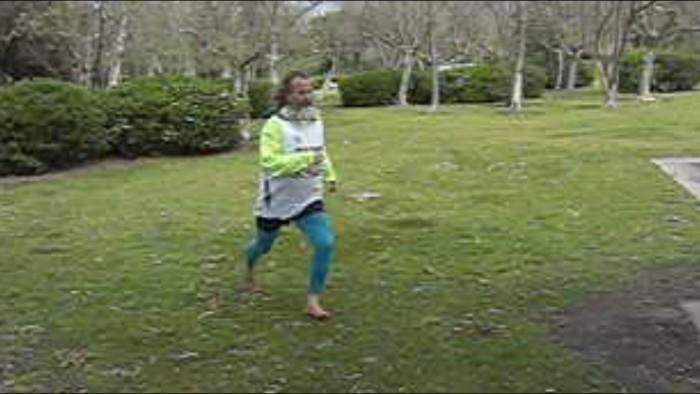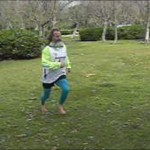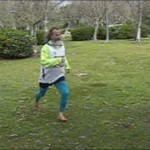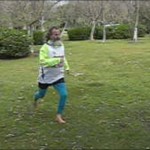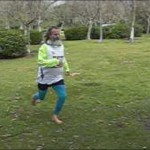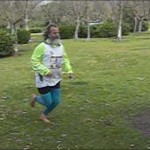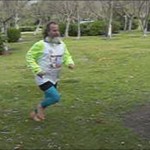How to Run Barefoot – or, at least, “as if you were barefoot”
The first thing a runner must know is how to run properly. Everything else follows from there. – Gordon Pirie, Running Fast and Injury Free
Remember to start at the Beginning!
Many have said, “It hurts so much to run with shoes, it must hurt more to run barefoot!”
If it would hurt to run barefoot, the way you run with shoes, then you aren’t running in shoes the way humans are designed to run!
Worse yet, if it hurts to run the way you run while wearing shoes… your shoes aren’t doing what you probably expect them to do – in other words, you’ve throw away your money, and if those are not the first pair of shoes you’ve bought – you’re acting like an absolute fool! … unless you get all your shoes free.
More to-the-point, you aren’t responding appropriately to that pain that is caused by running badly. Experiment – or play, like a child – while adjusting the way you run, so that Running Barefoot becomes very gentle, very efficient, and comfortable! … or at least “bare-able”…
Remember, there will be a lot of fine tuning as you learn to run barefoot. However, since many of you have been handicapped, by wearing shoes for a long part of your life, you most likely have learned how to run with many bad habits. It should be desirable to let go of those many bad habits and start, as an infant at the beginning.
So, just let it go…
… gone?
Good.
Now that you let it go, you can start at the beginning and experiment, first with standing, feeling, discovering, with the same wonder and curiosity as an infant. Then move on, gradually, to walking, and again, experimenting, discovering, wondering, feeling how things are working. And, finally, to running, again, pay attention to what your feet and body tell you, as you experiment, discover, and run with great curiosity.
For those who want to move along more quickly, I will share with you what I have learned from listening to my bare soles for more than half-a-century… You should still experiment and test these techniques out on your own bare soles.
Basically what we taught you in Barefoot Running Step by Step:
- Relax
- Vertical torso – upright and balanced (this way, you won’t expend extra energy keeping a leaning tower from falling), no slouching
- Relax
- Bend the knees (feel the pressure coming off the heels)
- Relax
- Hips lead the way (gently “push” your hips forward – actually, not even a “push”, just RELAX the ankles and ALLOW the hips to “FALL” forward)
- Relax
- Lift your feet early and quickly. Start lifing BEFORE landing (don’t worry, gravity will insure that your feet will land) – try to imagine spinning the peddles of a bicyle in low-gear.
- Relax
- When lifting the trailing foot, pull up on the front of the foot, keeping the heel down, and avoiding unnecessary and stressful push-off. If you feel your fore-foot pushing into the ground, then your ankles and calves aren’t relaxed enough.
- Relax
- Move your feet under your center of balance (so your body doesn’t wobble side to side)
- Relax
- Allow hips to rotate with your legs, and your shoulders to twist the opposite direction, (to counterbalance the movement of your legs and hips)
- Relax
- Swing each leg around from the side, to land on an imaginary line that stretches out in front of you to that point on the horizon (one foot in front of the other)
- Relax
- Keep your head facing forward (focus on a point, far off in the distance, in the direction you want to run)
- Relax
- Use your eyes to scan the surface in front of you, but keep going back to that point on the horizon which you are running toward.
- Relax
- relax
- Relax
- RELAX!
Moving Forward
Step by step not simple enough?
The most important thing to remember about running, is that it isn’t about “running”. To many people who want to run, TRY to run. And that often leads down a bad road.
Running and walking are about moving our body forward! Moving our body forward is where we should start. Most of the details above will fall into place if we simply focus on a point somewhere out in front of us, and move our body towards that point.
Don’t worry about cadence, stride length, foot landing, etc. at least not for now. Those are things you should have learned before.
Of course in order to reduce or eliminate those annoying and wasteful movements from side-to-side, and up-and-down bouncing, we’ll need to use some of the techniques I’ve mentioned above.
To avoid up-and-down bouncing, we’ll need to lower our body and bend our knees so that our body can maintain a more-or-less constant height while our legs move underneath our body. And we’ll want to avoid trying to launch our body by pushing off, and instead simply lift our feet, one-at-a-time, of course – unless you want to practice “hopping” technique – but that’s a whole other method, and not a very efficient way to travel (except for bunnies and kangaroos and some bugs too).
To avoid wasteful shifts of our body’s mass from side-to-side, we’ll need to rotate our hips a bit, so that each foot can land directly beneath our center of balance, without moving our center of balance from side-to-side. In other words, each foot will land on a line that extends out in the direction we want to run; forward!
Then we’ll need to counterbalance our hip rotation by rotating our upper torso in the opposite direction – this also reduces how much we need to swing our arms to counterbalance the alternate movement of our legs.
To continue moving forward, we’ll want to face forward; not the ground; not with our head swiveling form side-to-side; and certainly not with our head bouncing all over the place (I’ve seen runners doing just that).
What’s so important about relaxing? The alternative is to tense up. When we’re tense, we’re more rigid. If we’re more rigid, then we’ve lost all that marvelous springiness in our body, which naturally eliminates injurious impact. This springiness is the very thing we gain, when we can feel how painful being rigid hurts while running badly (especially in bare feet).
We’ll also want to keep our torso mostly vertical, so that our upper torso doesn’t pull us into the road face-first! (this is really just more elaboration about facing forward) Nor do we want our torso pulling us backwards … since that isn’t the direction we’re trying to run, at least not right now. Hmm… maybe that could be another chapter in itself?
